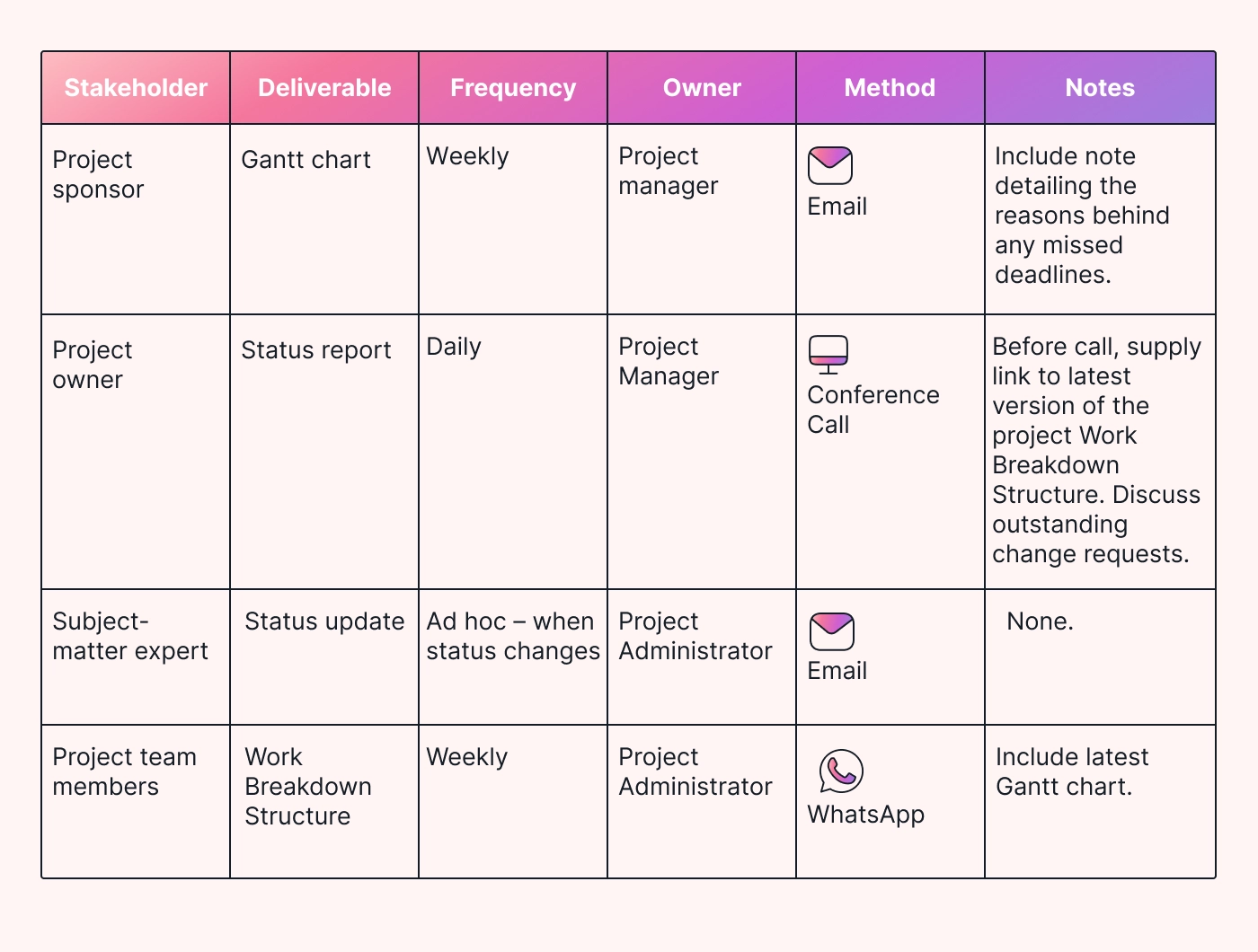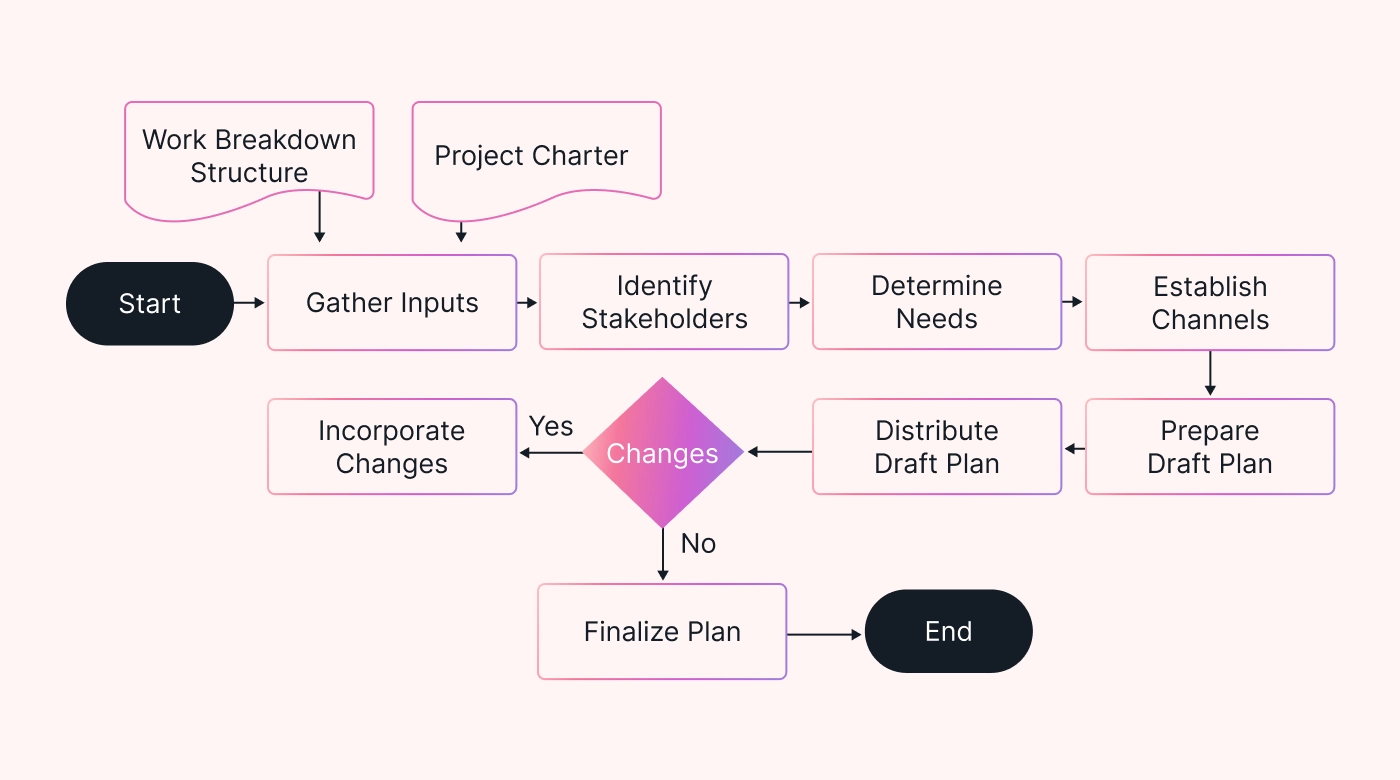Tired of juggling endless client queries and managing projects without a clear communication strategy?
Don’t let poor communication hold your projects back.
Imagine a world where your project team is always on the same page, deadlines are easily met, and communication flows seamlessly. This is the magic of mastering project communications management.
No more working outside of scope or fielding constant client change requests mid-project. In this article, we’ll show you how to create a communication process so streamlined that you’ll wonder why your inbox looks so empty.
What is project communications management?
First things first: project communications management ensures everyone on your team, your clients, and your project sponsor knows what’s happening and can work together smoothly.
At its core, it has three fundamental stages, as outlined in the PMBOK 6th edition:
- Creating a well-crafted Communication Management Plan (which we’ll show you how to do in this article)
- Making sure that all stakeholders are executing their communications as outlined in the communication management plan
- Ongoing monitoring and improvement of your plan: Ensuring the stuff in the plan gets done when it’s supposed to and that responses are addressed promptly. And making improvements based on the lessons learned to improve communications.
In your business, communications management will usually follow these steps:
- Identify and manage all stakeholders: Who will receive communication? What level of information do they need? How often should they receive it? This is also a key part of your overall stakeholder management before, during, and after your project.
- Set up clear communication channels: Make sure everyone knows how to reach each other (including the team, other stakeholders like the project sponsor, business owner, and even community members, where applicable). What communication methods should you use for each? Should it be emails, meetings, or messaging tools like Teams or Slack? Discuss everyone’s communication preferences as a team.
- Keep everyone updated: Regularly share progress, milestones, and any changes so everyone stays on the same page.
- Listen to your team: Encourage them to share their ideas and concerns. It helps build trust and makes everyone feel valued. Plus, let’s be honest, it’s your team that most needs to have communication to get the information they need. So, keep them informed.

- Document everything relevant: Keep records of discussions, decisions, and actions taken, to track progress and avoid misunderstandings, especially if clients request excessive updates or team members don’t respond within agreed timeframes.
- Be flexible: As the project manager, you own project communication management. Sometimes, you might need to adjust your types of communication based on the situation or people's preferences.
- Get feedback: Ask your team and stakeholders for their input. This helps improve regular communication and, most importantly, they feel heard.
By improving how project communications are managed, you can simplify collaboration. Plus, when problems do pop up, you have a plan to fall back on, or to modify, to create an environment for excellent communication.
What is a project communication plan?
A project communication plan provides a strategy for how you will talk to everyone involved in your project. It’s a game plan to ensure everyone gets the info they need when they need it.
So, it’s all about whom you’re talking to, what you’re saying, how you’re saying it. Make sure you’re listening too. Think of it as your project’s communication playbook that outlines who needs to speak to whom, by when, and how.
With a plan, all your stakeholders will have already agreed on how the information will be gathered, how, where, and when questions will be asked, and what type of reporting people need to stay on track.
When it’s time to review how your project went, you’ll use the plan as a guide to assess how communications were executed. This yields learning opportunities for your team and your clients.
It’s your guidepost for how people should communicate, even in the thick of project execution, when tensions can rise and overcommunication can cause further delays.
What is the goal of a project communication plan?
The main goal of an effective project management communication plan is to ensure everyone involved in the project knows what’s happening and stays connected.
For example, your client might need weekly status updates. You can commit to your client to provide this update every week, and they will learn to wait for it rather than just “checking in” whenever they feel like it. But this works both ways. If you commit to a weekly status update, you need to send it. Ultimately, it’s how the communication plan builds trust.
What does a project communication plan look like?
A project communication plan can be a text document or a visual chart that outlines the following:
- Who needs to be communicated with (stakeholders, team members, clients)
- What information needs to be communicated
- How and when communication will happen (channels, frequency, timing)
- Who is responsible for each communication task
- Any feedback mechanisms or ways to address concerns.
It could be a simple table or spreadsheet detailing these points or a more visual representation like a flowchart or timeline. The main idea is to have a clear plan that everyone involved can refer to for guidance on communication throughout the project.
Here’s one we prepared earlier:
As you can see, in the left column, we have the receiver stakeholders, then the deliverables they need, how often they require it, who will provide it, how it will be provided, and any additional information needed.
However, before we create a plan, it’s essential to understand what good communication looks like. Sometimes we are spread so thin that we want to fire off a quick reply without thinking about it. This can lead to misunderstandings. I mean, we’ve all misread a text, haven’t we?
What does effective communication look like?
We’ve all lost our tempers, or at least our cool when a project is going sideways, so what are some standards you can set when creating your communication plan with your team?
Effective communication skills include:
- Keep communication clear and concise: Use simple language and avoid jargon when speaking with clients.
- Active listening: Pay attention to what is being said and ask questions to ensure you have fully understood the meaning being conveyed.
- Be empathetic: Understand others’ perspectives and feelings.
- Try to be engaging: Capturing interest with stories or visuals can make your point easier to understand.
- Be feedback-driven: Encourage input and be open to criticism. This feedback will streamline things for next time.
- Be adaptable: Tailor communication to the audience’s needs. You wouldn’t speak to a new client like you would talk to a team member you’ve worked with for years.
- Always be respectful: Treat others courteously and professionally even if they aren’t treating you the same way. After all, you’re in a place of business.
- Keep your responses timely: Timely responses matter when communication is received via the correct channels per the communication plan. Make it part of your plan to specify how long responses should take from all stakeholders (e.g., 48 hours maximum).
Now, this isn’t just for you and your team. These principles also apply to your clients and can act as a good benchmark to weed out any clients you might be better off without.
7 reasons why a project communication plan is so important
A project communication plan is essential for ensuring everyone is on the same page and working together smoothly. Here’s why:
- Clarity and alignment: Without clear communication, things can get messy fast. An effective communication plan helps everyone understand what needs to be communicated, who's responsible for what, and when it needs to happen.
- Enhanced collaboration: When team members can easily share ideas, updates, and feedback, they can work together more effectively. Everyone is playing on the same team.
- Stakeholder engagement: Projects involve lots of people with different interests. A communication plan keeps everyone in the loop, from team members to clients and other stakeholders.
- Risk management: A communication plan clarifies how to report issues and who needs to be involved in fixing them. This stops small problems from becoming big disasters.
- Resource optimization: A communication plan helps avoid wasting time and effort by making sure everyone knows what to work on and when.
- Adaptability and flexibility: Projects change constantly, and good communication helps teams roll with the punches.
- Continuous improvement: Asking for feedback and learning from experience helps teams get better at communicating. A communication plan provides a framework for improving communications.
In short, a project communication plan isn't just another document — it's the glue that holds a project together, keeps everyone in sync, and helps teams achieve their goals without unnecessary distractions. Once you get this process down, you’ll wonder how you ever lived without it.
10 steps to creating a project communications management plan
To make sure your communication plan improves communication rather than adding even more complexity, here are ten things you can do right now:
1. Stakeholder identification: Simply jot down who’s involved, like team members, clients, and other important people who need to be kept in the loop.
2. Communication objectives: Figure out what you want to achieve with your messages. Maybe it’s keeping clients in the know, ensuring your team works well together, or getting the information they need quickly.
3. Communication channels: Decide how to talk to each group. You might email clients, use Slack for quick chats with your team, and have weekly sit-downs with key project team members in person.
4. Frequency and timing: Work out when and how often to touch base. Maybe clients get updates every Friday and your team meets up first thing every Monday morning.
5. Key messages: Pin down what's important to share with each group. Clients might want to know about big project milestones, while your team needs to know who's doing what by when, so they can schedule their work accordingly.
6. Responsibilities: Make clear who's handling what. A project manager might be in charge of talking to clients, while a more junior member might get an opportunity to lead internal chats.
7. Feedback mechanisms: Set up ways for people to share their thoughts. Clients can fill out a quick survey, or your team can speak up in internal team meetings about how communication has (or hasn’t) improved since implementing the communication plan.
8. Address change requests: What is the process if your client wants changes to the project mid-execution? How can they request changes? How will these be scheduled and billed?
Effective communication about change is crucial to ensure you manage scope. Changes mean additional cost and time (not offhand suggestions that creep in and add workload). Get your client on board with the change process.
9. Prepare your draft plan: Share it with everyone involved and get sign-off, to make it easier to rely on during project execution. If any changes are requested, address them before finalizing the document and before any project work begins.
10. Distribute your plan: Make sure everyone has a copy of the plan so it’s at hand when needed.
Formalize communication early, and you’ll pat yourself on the back later.
Three pro tips to maximize your project communications management
Here are three pro tips to help you get the most out of better communication management:
1. Manage your communications to the plan
- Planning is just one part of project communications management. If you’re not sticking to the plan you created, you’re wasting the efforts of everyone involved.
- But it doesn’t have to be complicated. Make it easier with project management apps and communication platforms to keep everyone connected. You can even automate reminders to keep the plan front of mind for everyone.
- Match the appropriate communication channel to the right stakeholder and watch as the back and forth slows (to the right pace).
2. Monitor progress and document lessons learned
- Foster an environment where team members (and clients) feel comfortable sharing ideas and concerns openly. As long as everyone focuses on improvement rather than criticism, you’ll make a safe space for productive communication.
- Make sure everyone knows their voice matters and encourage active participation in discussions. After all, if the goal is to stop the chaos mid-project, it’s better to get it all out on the table early.
- Track how well the plan is being followed, learn from mistakes, and make improvements as you go.
3. Let an AI-powered tool manage the manual load
- Consider integrating AI-powered project management tools to auto-schedule your meetings and recurring tasks (like regular reports), to eliminate manual administration.
- Streamline your workflows so providing status updates is as simple as taking a real-time screenshot of your live project board.
- Set reminders in advance of the status report or other comms due dates so you only have to think about content.
Better yet, why not try an AI-driven project communications assistant to carry your mental load?
Motion: Your project communications management sidekick
The days of working outside scope and fielding constant client changes are over. It’s time to optimize your communication with AI-powered Motion.
Motion is your ultimate project communication companion: no more surprises or endless back-and-forth with clients.
After you create your project tasks, assign them to your team, connect your dependencies, assign your priorities, and set your deadlines, Motion will automatically create and manage optimal calendar schedules for your team and other relevant stakeholders.
It knows their available work time and won’t over-allocate them. If things change, it will reschedule tasks to the next best time based on the most productive work day.
Just think how much unnecessary communication could be removed and how productive your team would be—no more time lost while your team decides what to work on next.
Take control of your projects and try Motion FREE today to experience the difference firsthand.

Haylee is a versatile writer with ten years of experience. With a background in marketing and writing for large SaaS companies, Haylee brings her passion for the written word to diverse projects ranging from blog posts and ebooks to direct marketing campaigns.








